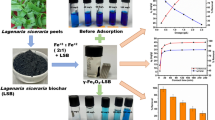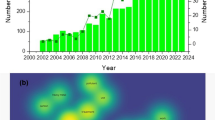Abstract
A three-dimensional (3D) robust sodium alginate/gelatin/graphene oxide (SGGO) triple-network composite aerogel was designed using a “hydrophilic assembly–sustained release gelation” two-step method. The resulting SGGO aerogel has an ordered fishing net-like microstructure, low density (16.2 mg/cm3), high porosity (93.5%), and abundant functional groups when only 3 wt% GO was incorporated. The reinforced mechanical strength can reach 0.37 MPa and 0.12 MPa under dry and wet states, respectively, and the dry strength can still reach 0.31 MPa without a significant loss after five compression cycles. A batch adsorption experiment was performed as a function of pH, contact time and initial concentration. Adsorption behavior followed the pseudo second-order kinetic model and Langmuir isotherm, yielding the maximum monolayer adsorption capacity of 322.6 mg/g and 196.8 mg/g for Methylene blue (MB) and Congo red (CR), respectively. Moreover, thermodynamic studies indicated a spontaneous and endothermic adsorption process. After five regeneration cycles, the adsorption capacity can reach 88.4% and 86.5% of the initial values for MB and CR, demonstrating a high-performance, recyclable and promising candidate for dye wastewater treatment.











Similar content being viewed by others
References
Dai L, Zhu W, He L, Tan F, Zhu N, Zhou Q, He M, Hu G (2018) Calcium-rich biochar from crab shell: an unexpected super adsorbent for dye removal. Bioresour Technol 267:510–516
Song W, Gao B, Xu X, Xing L, Han S, Duan P, Song W, Jia R (2016) Adsorption–desorption behavior of magnetic amine/Fe3O4 functionalized biopolymer resin towards anionic dyes from wastewater. Bioresour Technol 210:123–130
Aroguz AZ, Gulen J, Evers R (2008) Adsorption of methylene blue from aqueous solution on pyrolyzed petrified sediment. Bioresour Technol 99(6):1503–1508
Huang H, Liu J, Zhang P, Zhang D, Gao F (2017) Investigation on the simultaneous removal of fluoride, ammonia nitrogen and phosphate from semiconductor wastewater using chemical precipitation. Chem Eng J 307:696–706
El Samrani AG, Lartiges BS, Villieras F (2008) Chemical coagulation of combined sewer overflow: heavy metal removal and treatment optimization. Water Res 42(4–5):951–960
Wang L (2009) Aqueous organic dye discoloration induced by contact glow discharge electrolysis. J Hazard Mater 171(1–3):577–581
Yang Y, Zhao B, Tang P, Cao Z, Huang M, Tan S (2014) Flexible counter electrodes based on nitrogen-doped carbon aerogels with tunable pore structure for high-performance dye-sensitized solar cells. Carbon 77:113–121
Mohammed N, Grishkewich N, Berry RM, Tam KC (2015) Cellulose nanocrystal–alginate hydrogel beads as novel adsorbents for organic dyes in aqueous solutions. Cellulose 22(6):3725–3738
Barquist K, Larsen SC (2010) Chromate adsorption on bifunctional, magnetic zeolite composites. Micropor Mesopor Mat 130(1–3):197–202
Gesser H, Goswami P (1989) Aerogels and related porous materials. Chem Rev 89(4):765–788
Hüsing N, Schubert U (1998) Aerogels—airy materials: chemistry, structure, and properties. Angew Chem Int Ed 37(1–2):22–45
Jiao C, Xiong J, Tao J, Xu S, Zhang D, Lin H, Chen Y (2016) Sodium alginate/graphene oxide aerogel with enhanced strength-toughness and its heavy metal adsorption study. Int J Biol Macromol 83:133–141
Wang L, Shelton RM, Cooper PR, Lawson M, Triffitt JT, Barralet JE (2003) Evaluation of sodium alginate for bone marrow cell tissue engineering. Biomaterials 24(20):3475–3481
Rocher V, Siaugue J-M, Cabuil V, Bee A (2008) Removal of organic dyes by magnetic alginate beads. Water Res 42(4–5):1290–1298
Pettignano A, Tanchoux N, Cacciaguerra T, Vincent T, Bernardi L, Guibal E, Quignard F (2017) Sodium and acidic alginate foams with hierarchical porosity: preparation, characterization and efficiency as a dye adsorbent. Carbohyd Polym 178:78–85
Deze EG, Papageorgiou SK, Favvas EP, Katsaros FK (2012) Porous alginate aerogel beads for effective and rapid heavy metal sorption from aqueous solutions: effect of porosity in Cu2+ and Cd2+ ion sorption. Chem Eng J 209:537–546
Wan Y, Chen X, Xiong G, Guo R, Luo H (2014) Synthesis and characterization of three-dimensional porous graphene oxide/sodium alginate scaffolds with enhanced mechanical properties. Materials Express 4(5):429–434
Liu S, Li Y, Li L (2017) Enhanced stability and mechanical strength of sodium alginate composite films. Carbohyd Polym 160:62–70
Zhu T, Teng K, Shi J, Chen L, Xu Z (2016) A facile assembly of 3D robust double network graphene/polyacrylamide architectures via γ-ray irradiation. Compos Sci Technol 123:276–285
Zu G, Kanamori K, Shimizu T, Zhu Y, Maeno A, Kaji H, Nakanishi K, Shen J (2018) Versatile double-cross-linking approach to transparent, machinable, supercompressible, highly bendable aerogel thermal superinsulators. Chem Mater 30(8):2759–2770
Bao Z, Xian C, Yuan Q, Liu G, Wu J (2019) natural polymer-based hydrogels with enhanced mechanical performances: preparation, structure, and property. Adv Healthc Mater 8(17):1900670
Liu G, Yuan Q, Hollett G, Zhao W, Kang Y, Wu J (2018) Cyclodextrin-based host–guest supramolecular hydrogel and its application in biomedical fields. Polym Chem 9(25):3436–3449
May M, Wang H, Akid R (2010) Effects of the addition of inorganic nanoparticles on the adhesive strength of a hybrid sol–gel epoxy system. Int J Adhes 30(6):505–512
Wang C, Xiong Y, Fan B, Yao Q, Wang H, Jin C, Sun Q (2016) Cellulose as an adhesion agent for the synthesis of lignin aerogel with strong mechanical performance. Sound-absorption Therm Insulation Sci Rep 6:32383
Lin N, Meng Z, Toh GW, Zhen Y, Diao Y, Xu H, Liu XY (2015) Engineering of fluorescent emission of silk fibroin composite materials by material assembly. Small 11(9–10):1205–1214
Tabata Y, Ikada Y (1998) Protein release from gelatin matrices. Adv Drug Deliver Rev 31(3):287–301
Liu C, Liu H, Xu A, Tang K, Huang Y, Lu C (2017) In situ reduced and assembled three-dimensional graphene aerogel for efficient dye removal. J Alloy Compound 714:522–529
Jiang J, Zhang Q, Zhan X, Chen F (2019) A multifunctional gelatin-based aerogel with superior pollutants adsorption, oil/water separation and photocatalytic properties. Chem Eng J 358:1539–1551
Devi N, Kakati DK (2013) Smart porous microparticles based on gelatin/sodium alginate polyelectrolyte complex. J Food Eng 117(2):193–204
He Y, Zhang N, Gong Q, Qiu H, Wang W, Liu Y, Gao J (2012) Alginate/graphene oxide fibers with enhanced mechanical strength prepared by wet spinning. Carbohyd Polym 88(3):1100–1108
Marrella A, Lagazzo A, Barberis F, Catelani T, Quarto R, Scaglione S (2017) Enhanced mechanical performances and bioactivity of cell laden-graphene oxide/alginate hydrogels open new scenario for articular tissue engineering applications. Carbon 115:608–616
Fan L, Ge H, Zou S, Xiao Y, Wen H, Li Y, Feng H, Nie M (2016) Sodium alginate conjugated graphene oxide as a new carrier for drug delivery system. Int J Biol Macromol 93:582–590
Yun Y, Wu H, Gao J, Dai W, Deng L, Lv O, Kong Y (2020) Facile synthesis of Ca2+-crosslinked sodium alginate/graphene oxide hybrids as electro- and pH-responsive drug carrier. Mat Sci Eng 108:110380
Valentini L, Rescignano N, Puglia D, Cardinali M (2015) Kenny J (2015) Preparation of alginate/graphene oxide hybrid films and their integration in triboelectric generators. Eur J Inorg Chem 7:1192–1197
Feng J, Ding H, Yang G, Wang R, Li S, Liao J, Li Z, Chen D (2017) Preparation of black-pearl reduced graphene oxide-sodium alginate hydrogel microspheres for adsorbing organic pollutants. J Colloid Interf Sci 508:387–395
Ma J, Jiang Z, Cao J, Yu F (2019) Enhanced adsorption for the removal of antibiotics by carbon nanotubes/graphene oxide/sodium alginate triple-network nanocomposite hydrogels in aqueous solutions. Chemosphere 242:125188
Mohammadi A, Doctorsafaei AH, Zia KM (2018) Alginate/calix[4]arenes modified graphene oxide nanocomposite beads: preparation, characterization, and dye adsorption studies. Int J Biol Macromol 120:1353–1361
Hummers WS Jr, Offeman RE (1958) Preparation of graphitic oxide. J Am Chem Soc 80(6):1339–1339
Ingar DK, Kjetill Ø, Olav S (1989) Alginate-based solid media for plant tissue culture. Appl Microbiol Biot 31:79–83
Shan S, Tang H, Zhao Y, Wang W, Cui F (2019) Highly porous zirconium-crosslinked graphene oxide/alginate aerogel beads for enhanced phosphate removal. Chem Eng J 359:779–789
Lawrie G, Keen I, Drew B, Chandler-Temple A, Rintoul L, Fredericks P, Grøndahl L (2007) Interactions between alginate and chitosan biopolymers characterized using FTIR and XPS. Biomacromol 8(8):2533–2541
Yang C, Xu L, Zhou Y, Zhang X, Huang X, Wang M, Han Y, Zhai M, Wei S, Li J (2010) A green fabrication approach of gelatin/CM-chitosan hybrid hydrogel for wound healing. Carbohyd Polym 82(4):1297–1305
Liu L, Li C, Bao C, Jia Q, Xiao P, Liu X, Zhang Q (2012) Preparation and characterization of chitosan/graphene oxide composites for the adsorption of Au(III) and Pd(II). Talanta 93:350–357
Kim KH, Oh Y, Islam M (2012) Graphene coating makes carbon nanotube aerogels superelastic and resistant to fatigue. Nat Nanotechnol 7(9):562
Liu C, Liu H, Xiong T, Xu A, Pan B, Tang K (2018) Graphene oxide reinforced alginate/PVA double network hydrogels for efficient dye removal. Polymers (Basel) 10(8):835
Piao Y, Chen B (2017) Synthesis and mechanical properties of double cross-linked gelatin-graphene oxide hydrogels. Int J Biol Macromol 101:791–798
Shan C, Wang L, Li Z, Zhong X, Hou Y, Zhang L, Shi F (2019) Graphene oxide enhanced polyacrylamide-alginate aerogels catalysts. Carbohydr Polym 203:19–25
Liu L, Gao ZY, Su XP, Chen X, Jiang L, Yao JM (2015) Adsorption removal of dyes from single and binary solutions using a cellulose-based bioadsorbent. ACS Sustain Chem Eng 3(3):432–442
Aldegs Y, Elbarghouthi M, Elsheikh A, Walker G (2008) Effect of solution pH, ionic strength, and temperature on adsorption behavior of reactive dyes on activated carbon. Dyes Pigm 77(1):16–23
Tiwari JN, Mahesh K, Le NH, Kemp KC, Timilsina R, Tiwari RN, Kim KS (2013) Reduced graphene oxide-based hydrogels for the efficient capture of dye pollutants from aqueous solutions. Carbon 56:173–182
Huang X, Liao X, Shi B (2009) Hg (II) removal from aqueous solution by bayberry tannin-immobilized collagen fiber. J Hazard Mater 170(2–3):1141–1148
Jiao C, Tao J, Xiong J, Wang X, Zhang D, Lin H, Chen Y (2017) In situ synthesis of MnO2-loaded biocomposite based on microcrystalline cellulose for Pb2+ removal from wastewater. Cellulose 24(6):2591–2604
Tao J, Xiong J, Jiao C, Zhang D, Lin H, Chen Y (2016) Hybrid Mesoporous Silica Based on Hyperbranch-Substrate Nanonetwork as Highly Efficient Adsorbent for Water Treatment. ACS Sustain Chem Eng 4(1):60–68
Langmuir I (1918) The adsorption of gases on plane surfaces of glass, mica and platinum. J Am Chem Soc 40(9):1361–1403
Xu J, Wang L, Zhu Y (2012) Decontamination of bisphenol A from aqueous solution by graphene adsorption. Langmuir 28(22):8418–8425
Kumar KV, Kumaran A (2005) Removal of methylene blue by mango seed kernel powder. Biochem Eng J 27(1):83–93
Nollet H, Roels M, Lutgen P, Van der Meeren P, Verstraete W (2003) Removal of PCBs from wastewater using fly ash. Chemosphere 53(6):655–665
Kuo CY, Wu CH, Wu JY (2008) Adsorption of direct dyes from aqueous solutions by carbon nanotubes: determination of equilibrium, kinetics and thermodynamics parameters. J Colloid Interface Sci 327(2):308–315
Acknowledgements
This work was supported by the National Natural Science Foundation of China (NSFC) (Grant No. 51803004), Talent Project of Anhui Agricultural University (yj2018-18) and University Natural Science Research Project of Anhui Province (KJ2016A236).
Author information
Authors and Affiliations
Corresponding author
Ethics declarations
Conflict of interest
The authors declare that they have no conflict of interest.
Additional information
Publisher's Note
Springer Nature remains neutral with regard to jurisdictional claims in published maps and institutional affiliations.
Rights and permissions
About this article
Cite this article
Jiao, C., Li, T., Wang, J. et al. Efficient Removal of Dyes from Aqueous Solution by a Porous Sodium Alginate/gelatin/graphene Oxide Triple-network Composite Aerogel. J Polym Environ 28, 1492–1502 (2020). https://doi.org/10.1007/s10924-020-01702-1
Published:
Issue Date:
DOI: https://doi.org/10.1007/s10924-020-01702-1




